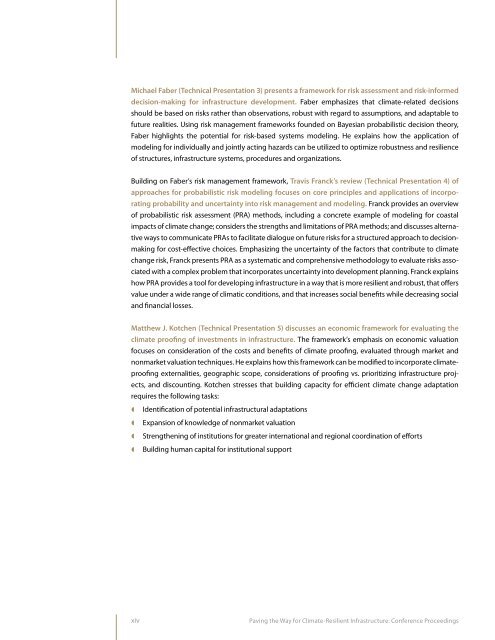Paving the Way for Climate-Resilient Infrastructure - UN CC:Learn
Paving the Way for Climate-Resilient Infrastructure - UN CC:Learn
Paving the Way for Climate-Resilient Infrastructure - UN CC:Learn
You also want an ePaper? Increase the reach of your titles
YUMPU automatically turns print PDFs into web optimized ePapers that Google loves.
Michael Faber (Technical Presentation 3) presents a framework <strong>for</strong> risk assessment and risk-in<strong>for</strong>meddecision-making <strong>for</strong> infrastructure development. Faber emphasizes that climate-related decisionsshould be based on risks ra<strong>the</strong>r than observations, robust with regard to assumptions, and adaptable tofuture realities. Using risk management frameworks founded on Bayesian probabilistic decision <strong>the</strong>ory,Faber highlights <strong>the</strong> potential <strong>for</strong> risk-based systems modeling. He explains how <strong>the</strong> application ofmodeling <strong>for</strong> individually and jointly acting hazards can be utilized to optimize robustness and resilienceof structures, infrastructure systems, procedures and organizations.Building on Faber’s risk management framework, Travis Franck’s review (Technical Presentation 4) ofapproaches <strong>for</strong> probabilistic risk modeling focuses on core principles and applications of incorporatingprobability and uncertainty into risk management and modeling. Franck provides an overviewof probabilistic risk assessment (PRA) methods, including a concrete example of modeling <strong>for</strong> coastalimpacts of climate change; considers <strong>the</strong> strengths and limitations of PRA methods; and discusses alternativeways to communicate PRAs to facilitate dialogue on future risks <strong>for</strong> a structured approach to decisionmaking<strong>for</strong> cost-effective choices. Emphasizing <strong>the</strong> uncertainty of <strong>the</strong> factors that contribute to climatechange risk, Franck presents PRA as a systematic and comprehensive methodology to evaluate risks associatedwith a complex problem that incorporates uncertainty into development planning. Franck explainshow PRA provides a tool <strong>for</strong> developing infrastructure in a way that is more resilient and robust, that offersvalue under a wide range of climatic conditions, and that increases social benefits while decreasing socialand financial losses.Mat<strong>the</strong>w J. Kotchen (Technical Presentation 5) discusses an economic framework <strong>for</strong> evaluating <strong>the</strong>climate proofing of investments in infrastructure. The framework’s emphasis on economic valuationfocuses on consideration of <strong>the</strong> costs and benefits of climate proofing, evaluated through market andnonmarket valuation techniques. He explains how this framework can be modified to incorporate climateproofingexternalities, geographic scope, considerations of proofing vs. prioritizing infrastructure projects,and discounting. Kotchen stresses that building capacity <strong>for</strong> efficient climate change adaptationrequires <strong>the</strong> following tasks:Identification of potential infrastructural adaptationsExpansion of knowledge of nonmarket valuationStreng<strong>the</strong>ning of institutions <strong>for</strong> greater international and regional coordination of ef<strong>for</strong>tsBuilding human capital <strong>for</strong> institutional supportxiv<strong>Paving</strong> <strong>the</strong> <strong>Way</strong> <strong>for</strong> <strong>Climate</strong>-<strong>Resilient</strong> <strong>Infrastructure</strong>: Conference Proceedings
















